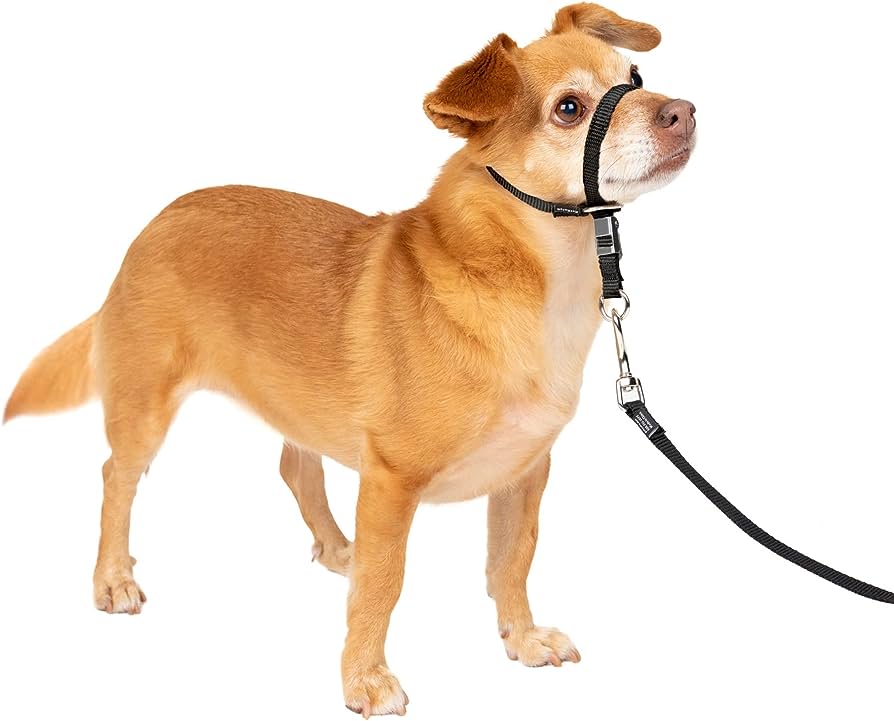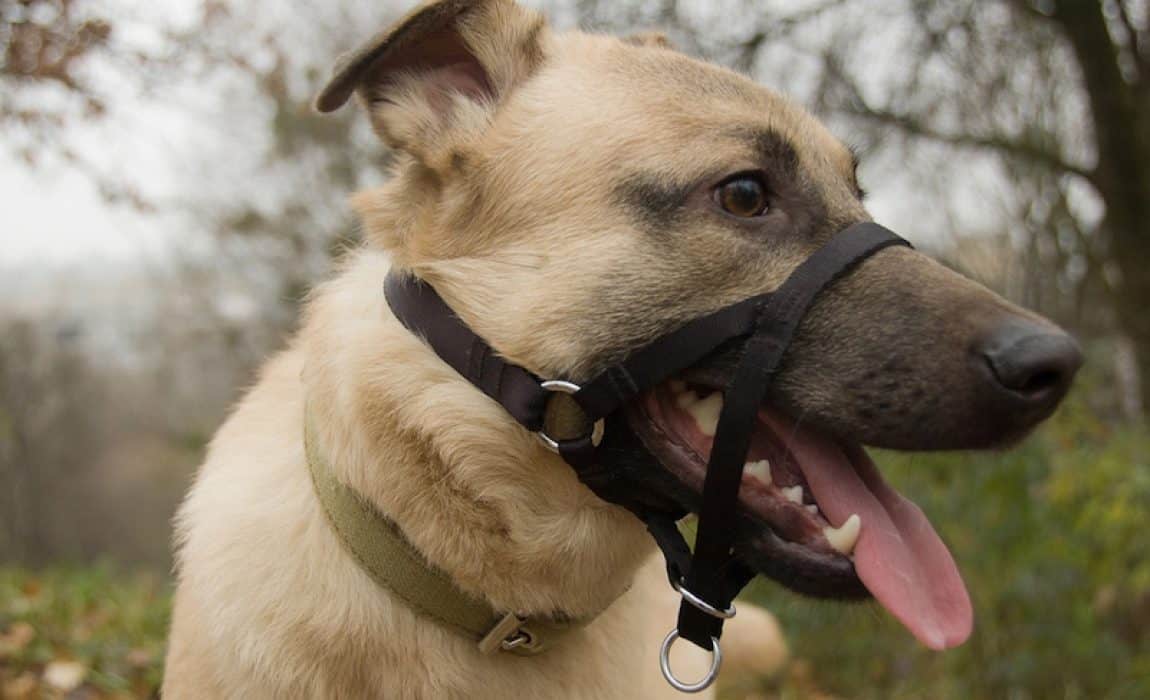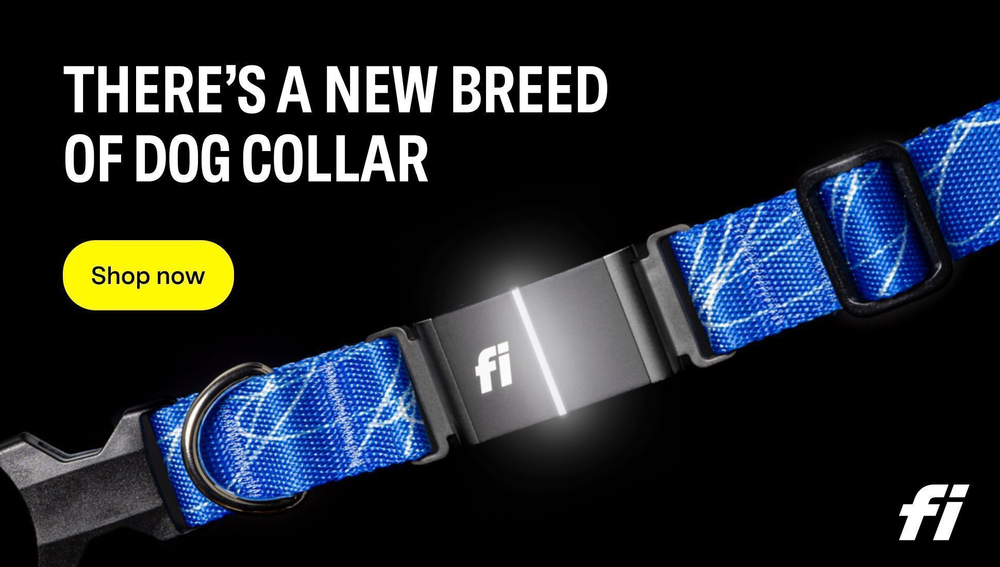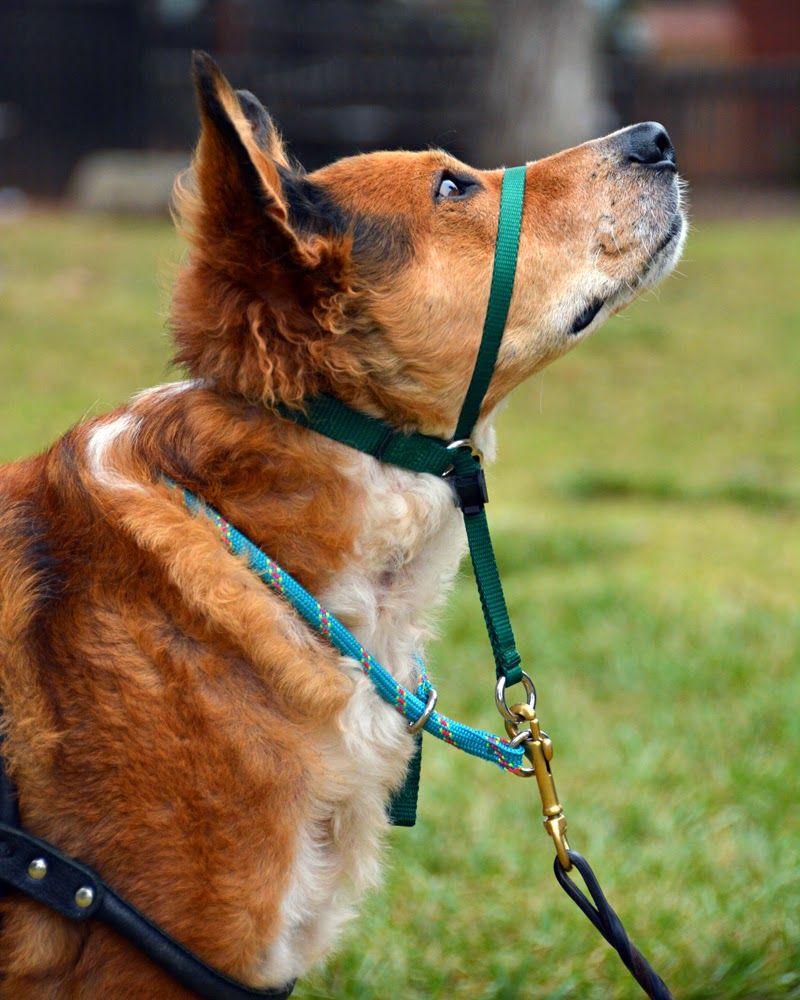When it comes to enjoying peaceful walks with your canine companion, the Gentle Leader emerges as a valuable tool. In this article, we'll delve into the world of the Gentle Leader, exploring what it is, how it works, and why it might be the solution you've been searching for to improve your dog's behavior during walks.

What is a Gentle Leader?
A Gentle Leader is a dog training tool designed to provide owners with better control over their dogs while on a leash. Unlike traditional collars or harnesses, the Gentle Leader employs a unique design that redirects your dog's attention and discourages pulling.
How does it work?
The Gentle Leader features a snug-fitting nose loop that gently applies pressure to the dog's muzzle when they pull. This sensation is not painful but serves as a natural deterrent for dogs, encouraging them to walk beside you with less resistance.
Benefits of Using a Gentle Leader
Using a Gentle Leader for your dog offers numerous benefits that can greatly improve your walking experience and your dog's behavior. Here's a closer look at why this training tool is highly recommended:
Effective Training Tool
The Gentle Leader serves as an effective training aid, helping you communicate your expectations to your dog. It encourages them to pay attention and walk calmly by your side. With consistent use, it can reinforce desirable walking behaviors, making your walks more enjoyable.
Enhanced Control and Safety
One of the primary advantages of the Gentle Leader is the enhanced control it provides. When your dog wears it, you have better control over their movements. This is particularly valuable in busy or potentially hazardous environments, ensuring your dog stays close and safe. It reduces the risk of your dog suddenly lunging or pulling away.
Reducing Pulling and Lunging
Do you find yourself struggling with a happy dog that constantly pulls or lunges during walks? The Gentle Leader can be a game-changer. The design of the Gentle Leader, with a snug-fitting nose loop, gently applies pressure to your dog's muzzle when they pull. This sensation is not painful but serves as a natural deterrent. Over time, your dog learns that pulling doesn't get them where they want to go, making your walks more relaxed and enjoyable.
Choosing the Right Gentle Leader
Selecting the appropriate Gentle Leader for your dog is crucial to ensure both comfort and effectiveness. Here's what you need to consider:
Consider Your Dog's Size and Breed
Different breeds have different needs when it comes to training tools like the Gentle Leader. Consider your dog's size and breed when choosing the right one. Some models are designed specifically for small breeds, while others are suitable for larger dogs. Ensuring the right fit will contribute to your dog's comfort during walks.

Fitting and Adjusting the Gentle Leader
Proper fitting and adjustment are key to the Gentle Leader's success. Even if you've chosen the right size, it's essential to follow fitting instructions carefully. The Gentle Leader should fit snugly but not too tight. It should allow your dog to open their mouth comfortably and pant without restrictions. Regularly check and adjust the fit as needed, especially if your dog is still growing.
Training Your Dog to Accept the Gentle Leader
Introducing your dog to the Gentle Leader may require some patience and positive reinforcement. Here's a step-by-step guide on how to train your dog to accept and use the Gentle Leader effectively:
Positive Reinforcement
- Start Indoors: Begin the training process indoors where your dog feels comfortable and safe. Allow your dog to examine the Gentle Leader, but do not force it on them.
- Treats and Praise: Use treats and praise to create a positive association with the Gentle Leader. Show your dog the Gentle Leader, and when they approach it without fear, reward them with treats and enthusiastic praise. Repeat this several times over several days.
- Incremental Progress: Gradually progress to touching the Gentle Leader to your dog's nose without securing it. Reward your dog for remaining calm and allowing you to do this.
- Short Sessions: Keep training sessions short, around 5-10 minutes, to prevent your dog from becoming overwhelmed. Always end on a positive note.
- Securing the Gentle Leader: Once your dog is comfortable with the Gentle Leader touching their nose, gently secure it in place. Ensure it's snug but not too tight. Reward your dog with treats and praise for wearing it.
- Practice Indoors: Allow your dog to wear the Gentle Leader indoors for short periods. Continue to reward them with treats and positive reinforcement to reinforce the idea that wearing it is a positive experience.
- Gradual Outdoor Introduction: When your dog is comfortable wearing the Gentle Leader indoors, move to outdoor training in a quiet, familiar environment. Continue to reward good behavior.
- Practice Patience: Understand that some dogs may take longer to adjust to the Gentle Leader than others. Be patient, and never use force or punishment during the training process.
Common Mistakes to Avoid
While using a Gentle Leader can be highly effective, there are some common mistakes that dog owners should avoid to ensure the safety and well-being of their pets:

Improper Fitting
- Avoid a Loose Fit: A loose Gentle Leader can be ineffective and may allow your dog to slip out of it. Ensure it fits snugly but comfortably.
- Not Allowing Panting: Make sure the Gentle Leader allows your dog to open their mouth and pant freely. This is essential for their comfort and safety, especially on hot days.
Using Excessive Force
- No Jerking or Pulling: Never jerk the leash or apply excessive force when using the Gentle Leader. It's designed to work gently through pressure, not force.
- Avoid Yanking: Do not yank on the leash, as this can cause discomfort and potentially harm your dog.
Inconsistent Use
- Consistency is Key: To see positive results, use the Gentle Leader consistently during walks. Inconsistent use can confuse your dog and undermine training progress.
- Transition Period: If you're switching from another type of GPS dog collar or harness, allow your dog a transition period to adapt to the Gentle Leader. This may take some time.
Alternatives to the Gentle Leader
While the Gentle Leader is a popular choice for training and walking dogs, it's not the only option available. Here are some alternatives to consider:
Harnesses
- Front-Clip Harness: Front-clip harnesses are designed to reduce pulling by redirecting your dog's attention towards you when they pull. They are a more comfortable option for dogs that may not tolerate something around their muzzle.
- Back-Clip Harness: Back-clip harnesses are easy to put on and are suitable for dogs that don't pull excessively. However, they may not provide as much control as a Gentle Leader.
- No-Pull Harness: No-pull harnesses are specifically designed to discourage pulling. They often have a front attachment point that reduces the dog's ability to pull forward.
Traditional Collars
- Flat Collar: Traditional flat collars are simple and lightweight. They are suitable for dogs that walk calmly on a leash. Ensure that the collar is properly fitted and not too tight.
- Martingale Collar: Martingale collars are designed to prevent dogs from slipping out of their collars, making them a good choice for dogs with narrower heads, like Greyhounds.
- Prong or Pinch Collar: Prong collars should only be used under the guidance of a professional dog trainer. They are not recommended for inexperienced dog owners.
Safety Precautions
When using any training tool, including the Gentle Leader, it's essential to prioritize your dog's safety. Here are some safety precautions to keep in mind:
Regular Inspection
- Inspect the Gentle Leader: Regularly check the Gentle Leader for signs of wear and tear. Look for any frayed straps or damaged parts. Replace it if you notice any issues.
- Leash Attachment: Ensure that the leash attachment is secure and not damaged. A broken leash attachment can lead to your dog escaping.
Monitoring for Signs of Discomfort
- Watch for Chafing: Check your dog's skin for signs of chafing or irritation. If you notice any, adjust the fit or consider using an alternative training tool.
- Behavioral Changes: Pay attention to your dog's behavior while wearing the Gentle Leader. If they seem distressed, anxious, or uncomfortable, it's crucial to address their concerns.
- Allow Breaks: During walks, allow your dog short breaks to sniff, explore, and relax. Don't keep constant tension on the leash.
- Hot Weather Considerations: In hot weather, be cautious about prolonged use of the Gentle Leader, as it can restrict panting. Ensure your dog stays well-hydrated.
- Proper Training: Train your dog to accept and wear the Gentle Leader gradually. Rushing the process can lead to stress and discomfort.

Real-Life Success Stories
To truly understand the impact of the Gentle Leader, let's explore a couple of real-life success stories where this training tool has made a significant difference in the lives of dogs and their owners.
Case Study: Transforming a Puller
Meet Max, a spirited Labrador Retriever who used to make every walk feel like a tug-of-war. Max's owner, Sarah, had tried various training methods and collars, but Max's natural inclination to pull remained a challenge.
Sarah decided to give the Gentle Leader a try after hearing positive reviews from friends. She followed the training guidelines diligently, starting with indoor sessions to familiarize Max with the device.
With time and patience, Max began to associate the Gentle Leader with positive experiences, thanks to Sarah's consistent use of treats and praise. Gradually, they transitioned to outdoor walks, where Max's pulling behavior remarkably decreased.
Today, Max is a different dog on walks. He no longer pulls incessantly, and Sarah can enjoy peaceful strolls through the park. The Gentle Leader transformed Max from a frustrated puller to a well-behaved walker, creating a happier experience for both Max and Sarah.
Enhancing Walks with a Gentle Leader
Julia, a dedicated dog owner, had always enjoyed walks with her Golden Retriever, Bella. However, as Bella grew stronger, she developed a habit of pulling on the leash, making walks less enjoyable for Julia and a strain on her shoulder.
After researching training solutions, Julia decided to try the Gentle Leader. She carefully fitted it to Bella, ensuring it was comfortable and secure. The initial outdoor walks with the Gentle Leader presented some challenges as Bella adapted to the new sensation, but Julia remained patient.
Over time, Bella became more accustomed to the Gentle Leader, and her pulling behavior reduced significantly. Julia could now walk her beloved Golden Retriever without feeling like she was in a tug-of-war.
The Gentle Leader not only improved their walks but also strengthened the bond between Julia and Bella. It became a valuable tool in their daily routine, enhancing their overall quality of life.
These real-life success stories demonstrate how the Gentle Leader can transform challenging walking experiences into enjoyable and harmonious ones, benefiting both dogs and their loving owners.
Facts About the Gentle Leader
The Gentle Leader is a unique dog training tool that has gained popularity for its effectiveness in improving leash training manners and providing better control during walks. Here are some essential facts about the Gentle Leader:
- Designed for Training: The Gentle Leader is primarily designed to help train dogs to walk politely on a leash. Its design focuses on redirecting a dog's attention away from pulling and lunging behaviors.
- Gentle Pressure: Instead of relying on force or discomfort, the Gentle Leader applies gentle pressure around the dog's muzzle. This pressure mimics the natural way dogs communicate with each other and serves as a deterrent to pulling.
- Comfortable Fit: When properly fitted, the Gentle Leader is comfortable for dogs to wear. It should not cause pain, restrict breathing, or hinder their ability to open their mouths.
- Not a Muzzle: While the Gentle Leader covers a dog's nose, it is not a muzzle that prevents them from eating, drinking, or panting. Dogs can still perform these essential activities while wearing it.

- Positive Reinforcement: Training with the Gentle Leader often involves positive reinforcement techniques, such as treats and praise, to create a positive association with wearing it. This encourages dogs to accept and even enjoy wearing it.
- Gradual Introduction: Introducing the Gentle Leader to a dog should be done gradually, starting with short indoor sessions and progressing to outdoor walks. This gradual approach helps dogs acclimate to the new sensation.
- Size Varieties: The Gentle Leader comes in various sizes to accommodate different dog breeds and sizes. It's essential to choose the right size to ensure a proper fit and effectiveness.
- Training Tool: While the Gentle Leader can significantly reduce pulling and lunging, it is most effective when used as part of a comprehensive training program that includes positive reinforcement and consistency.
- Not Suitable for All Dogs: While the Gentle Leader is suitable for many dogs, it may not be the best choice for every canine. Some dogs may not tolerate it well or may have specific behavioral issues that require different training methods.
- Regular Inspection: Dog owners should regularly inspect the Gentle Leader for wear and tear, ensuring that it remains safe and functional. Replacement may be necessary if it becomes damaged.
- Professional Guidance: If you're unsure about using the Gentle Leader or encounter difficulties during training, consider seeking advice from a professional dog trainer or behaviorist. They can provide tailored guidance.
- Safety First: Always prioritize your dog's safety and well-being when using any training tool, including the Gentle Leader. If your dog shows signs of discomfort or distress while wearing it, discontinue its use and consult a professional.
The Gentle Leader, when used correctly and with patience, can be a valuable tool for dog owners seeking to improve their dog's leash manners and enjoy more relaxed and enjoyable walks.
Conclusion
In conclusion, the Gentle Leader is a valuable tool for enhancing your dog's walking experience while providing you with greater control. With the right fit and proper training, you can enjoy peaceful and enjoyable walks with your four-legged friend. Remember that patience, consistency, and positive reinforcement are key to success.
Frequently Asked Questions (FAQs)
Here are some common questions regarding the Gentle Leader.
Q1: Is a Gentle Leader suitable for all dogs?
The Gentle Leader is generally suitable for most dogs, but individual preferences and needs may vary.
Q2: Can I use a Gentle Leader on a puppy?
While it's possible to use a Gentle Leader on a puppy, it's essential to ensure a proper fit and use it gently.
Q3: What if my dog dislikes wearing the Gentle Leader?
If your dog is initially uncomfortable, use positive reinforcement and give them time to adjust.
Q4: Are there any breed-specific considerations?
Some breeds may require specific adjustments, so consult your vet or a professional trainer if you have concerns.
Q5: Can I use a Gentle Leader for aggressive dogs?
A Gentle Leader can be effective for managing aggressive behavior, but consult a professional for guidance.






